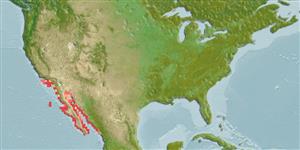>
Eupercaria/misc (Various families in series Eupercaria) >
Labridae (Wrasses) > Corinae
Etymology: Halichoeres: Greek, als, alis = salt + Greek, choiros = pig (Ref. 45335).
More on author: Ayres.
Environment: milieu / climate zone / depth range / distribution range
Ecología
marino asociado a arrecife; rango de profundidad 0 - 24 m (Ref. 2850). Subtropical; 34°N - 23°N, 121°W - 106°W
Eastern Pacific: Point Conception in California, USA to Guadalupe Island (off north-central Baja California) and the Gulf of California in Mexico.
Tamaño / Peso / Age
Maturity: Lm ? range ? - ? cm
Max length : 38.0 cm TL macho / no sexado; (Ref. 2850); edad máxima reportada: 14 años (Ref. 56049)
Found close to rocks near patches of sand and in tide pools. Dart into sand when disturbed and sleep at night buried in sand with head protruding. Feed on gastropods, small crustaceans and has been observed to pick ectoparasites from other fishes (Ref. 9311). Each individual functions first as female but changes to a male at length of about 30 cm. Pelagic spawners (Ref. 56049).
Life cycle and mating behavior
Madurez | Reproducción | Puesta | Huevos | Fecundidad | Larva
Pelagic spawner (Ref. 56049). Changes sex at 30 cm (Ref. 2850).
Eschmeyer, W.N., E.S. Herald and H. Hammann, 1983. A field guide to Pacific coast fishes of North America. Boston (MA, USA): Houghton Mifflin Company. xii+336 p. (Ref. 2850)
IUCN Red List Status (Ref. 130435: Version 2024-1)
Threat to humans
Harmless
Human uses
Pesquerías: comercial; Acuario: Comercial
Herramientas
Special reports
Download XML
Fuentes de Internet
Estimates based on models
Preferred temperature (Ref.
123201): 16.7 - 24.2, mean 22.3 °C (based on 103 cells).
Phylogenetic diversity index (Ref.
82804): PD
50 = 0.5000 [Uniqueness, from 0.5 = low to 2.0 = high].
Bayesian length-weight: a=0.00977 (0.00468 - 0.02039), b=3.09 (2.92 - 3.26), in cm total length, based on LWR estimates for this Genus-body shape (Ref.
93245).
Nivel trófico (Ref.
69278): 3.3 ±0.39 se; based on food items.
Resiliencia (Ref.
120179): Medio, población duplicada en un tiempo mínimo de 1.4-4.4 años (tm=2; tmax=14).
Fishing Vulnerability (Ref.
59153): Low to moderate vulnerability (28 of 100).
Nutrients (Ref.
124155): Calcium = 32.3 [14.8, 63.9] mg/100g; Iron = 0.591 [0.326, 1.149] mg/100g; Protein = 19.3 [16.4, 21.5] %; Omega3 = 0.195 [0.114, 0.338] g/100g; Selenium = 12.9 [6.4, 25.0] μg/100g; VitaminA = 56 [17, 229] μg/100g; Zinc = 0.922 [0.613, 1.576] mg/100g (wet weight);
